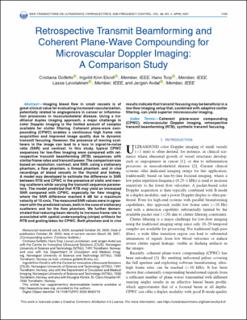| dc.contributor.author | Golfetto, Cristiana | |
| dc.contributor.author | Ekroll, Ingvild Kinn | |
| dc.contributor.author | Torp, Hans | |
| dc.contributor.author | Løvstakken, Lasse | |
| dc.contributor.author | Avdal, Jørgen | |
| dc.date.accessioned | 2021-04-19T08:52:42Z | |
| dc.date.available | 2021-04-19T08:52:42Z | |
| dc.date.created | 2020-11-17T09:34:46Z | |
| dc.date.issued | 2020 | |
| dc.identifier.citation | IEEE Transactions on Ultrasonics, Ferroelectrics and Frequency Control. 2021, 68 (4), . | en_US |
| dc.identifier.issn | 0885-3010 | |
| dc.identifier.uri | https://hdl.handle.net/11250/2738280 | |
| dc.description.abstract | Imaging blood flow in small vessels is of great clinical value for evaluating increased vascularization, potentially related to angiogenesis in cancer or inflammation processes in musculoskeletal disease. Using a traditional duplex imaging approach, a major challenge in color Doppler imaging is the limited amount of samples available for clutter filtering. Coherent plane-wave compounding (CPWC) enables a continuous high frame rate acquisition and improved image quality due to dynamic transmit focusing. However, the presence of moving scatterers in the image can lead to a loss in signal-to-noise ratio (SNR) and contrast. In this study, typical CPWC sequences for low-flow imaging were compared with retrospective transmit beamforming (RTB) sequences with similar frame rates and transmit power. The comparison was based on resolution, contrast, and SNR, using a stationary phantom, a flow phantom, a thread phantom, and in vivo recordings of blood vessels in the thyroid and kidney. A model was developed to estimate the difference in SNR between RTB and CPWC in the presence of static and moving scatterers while varying the transmit sequence parameters. The model predicted that RTB may yield an increased SNR compared with CPWC, especially for flow imaging, where the SNR difference reached 6 dB for a maximum velocity of 15 cm/s. The measured SNR values were in agreement with the predicted values, both in the case of stationary scatterers and for the flow phantom. We further demonstrated that reducing beam density to increase frame rate is associated with spatial undersampling (stripe) artifacts for RTB and grating lobes for CPWC. Both phantom and in vivo results indicate that transmit focusing may be beneficial in a low-flow imaging setup that, combined with adaptive clutter filtering, can yield superior microvascular imaging. | en_US |
| dc.language.iso | eng | en_US |
| dc.publisher | Institute of Electrical and Electronics Engineers (IEEE) | en_US |
| dc.rights | Navngivelse 4.0 Internasjonal | * |
| dc.rights.uri | http://creativecommons.org/licenses/by/4.0/deed.no | * |
| dc.title | Retrospective Transmit beamforming and Coherent Plane-Wave Compounding for Microvascular Doppler Imaging: A Comparison Study | en_US |
| dc.type | Peer reviewed | en_US |
| dc.type | Journal article | en_US |
| dc.description.version | publishedVersion | en_US |
| dc.source.volume | 68 | en_US |
| dc.source.journal | IEEE Transactions on Ultrasonics, Ferroelectrics and Frequency Control | en_US |
| dc.source.issue | 4 | en_US |
| dc.identifier.doi | 10.1109/TUFFC.2020.3033719 | |
| dc.identifier.cristin | 1848642 | |
| dc.relation.project | Samarbeidsorganet mellom Helse Midt-Norge og NTNU: 90165300 | en_US |
| dc.relation.project | Norges forskningsråd: 237887 | en_US |
| dc.description.localcode | Open Access CC-BY | en_US |
| cristin.ispublished | true | |
| cristin.fulltext | original | |
| cristin.qualitycode | 1 | |

